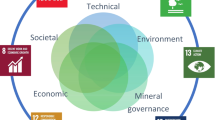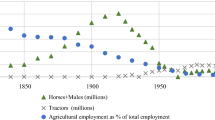Abstract
The sustainable development of modern agriculture must not only support the sustainable development of the industry itself, but also must realize the recycling of industrial accessories (such as agricultural waste) and the exploitation of potential. As an important part of the development of the concept of circular economy, an important part of circular agricultural technology is the conversion and utilization of waste sources. This is a new type of agricultural technology aimed at pursuing higher efficiency, reducing pollution, and increasing more employment goals. It can be seen that the initiation and implementation of agricultural waste recycling technology is the meaning of sustainable agricultural development. However, with the development of current technology, problems such as the lack of the concept of circular economy and the understanding of the main body of agricultural waste recycling, the incomplete service system, and the lagging of supporting policies and measures have emerged. Consistent with this, this paper uses GrcGIS and other methods to draw a gradient map to ensure that the protection of mountain plants in the mountainous area of City A is implemented at the district/county and city level. This confirms that the diversity of mountain plant protection is consistent at the district/county and city levels, that is, areas with the most species diversity contain more endangered species. Finally, the article expounds the status quo of China’s legal regulation of recycling and the consequences of model analysis, and puts forward the countermeasures and suggestions on China’s legal regulation of recycling, such as legislation, management system, statistical information collection and release system resources, law enforcement procedures, and initial allocation of rights.
















Similar content being viewed by others
Change history
23 November 2021
This article has been retracted. Please see the Retraction Notice for more detail: https://doi.org/10.1007/s12517-021-09081-0
28 September 2021
An Editorial Expression of Concern to this paper has been published: https://doi.org/10.1007/s12517-021-08471-8
References
Amman AA, Michalke B, Schramel P (2002) Speciation of heavy metals in environmental water by ion chromatography coupled to ICP-MS. Anal Biochem 372:448–452
Bakan G, Boke Ozkoc H, Tulek S, Cuce H (2010) Integrated environmental quality assessment of Kızılırmak River and its coastal environment. Turk J Fish Aquat Sci 10:453–462
Celerier J, Harrison TM, Beyssac O, Herman F, Dunlap WJ, Webb AAG (2009) The Kumaun and Garwhal Lesser Himalaya, India: part 2. Therm Deformation Hist GSA Bull 121:1281–1297. https://doi.org/10.1130/B26343.1
Delbart NJ-P, Kergoats L, Le Toan T, Lhermitte J, Picard G (2005) Determination of phenological dates in boreal regions using Normalized Difference Water Index. Remote Sens Environ 97(1):26–38. https://doi.org/10.1016/j.rse.2005.03.011
Gao BC (1996) NDWI A Normalized Difference Water Index for remote sensing of vegetation liquid water from space. Remote Sens Environ 58(3):257–266
Huang F, Yao C, Liu W, Li Y, Liu X (2018) Landslide susceptibility assessment in the Nantian area of China: a comparison of frequency ratio model and support vector machine. Geomat Nat Hazards Risk 9:919–938
Jia GJ, Epstein HE, Walker DA (2009) Vegetation greening in the Canadian Arctic related to decadal warming. J Environ Monit 11(12):2231–2238. https://doi.org/10.1039/b911677j
Kumar SK, Chandrasekar N, Seralathan P, Godson PS, Magesh NS (2012) Hydrogeochemical study of shallow carbonate aquifers, Rameswaram Island, India. Environ Monit Assess 184(7):4127–4138
Kumar P, Kumar KR, Nigam Anjani K (2015) Assessment and management of Ganga River water quality using multivariate statistical techniques in India. Asian J Water Environ Pollut 12:61–69. https://doi.org/10.3233/AJW-150018
Morris RD, Naumova EN, Levin R, Munasinghe RL (1996) Temporal variation in drinking water turbidity and diagnosed gastroenteritis in Milwaukee. Am J Public Health 86(2):237–239
Mukherjee D, Chattopadhyay M, Lahiri SC (1993) Water quality of the River Ganga (the Ganges) and some of its physico-chemical properties. Environmentalist 13(3):199–210
Ols C, Kålås IH, Drobyshev I, Söderström L, Hofgaard A (2019) Spatiotemporal variation in the relationship between boreal forest productivity proxies and climate data. Dendrochronologia. 58:125648. https://doi.org/10.1016/j.dendro.2019.125648
Panidi E, Tsepelev V (2017) NDWI-based technique for detection of change dates of the growing seasons in Russian subarctic. Int Arch Photogramm Remote Sens Spat Inf Sci XLII-3(W2):179–182
Paul D (2017) Research on heavy metal pollution of river Ganga: a review. Ann Agrar Sci 15:278–286. https://doi.org/10.1016/j.aasci.2017.04.001
Su H, Liu H, Wu Q (2015) Prediction of water depth from multispectral satellite imagery—the regression kriging alternative. IEEE Geosci Remote Sens Lett 12(12):2511–2515. https://doi.org/10.1109/LGRS.2015.2489678
Sulaiman M, El-Shafie A, Karim O, Basri H (2011) Improved water level forecasting performance by using optimal steepness coefficients in an artificial neural network. Water Resour Manag 25:2525–2541. https://doi.org/10.1007/s11269-011-9824-z
Tamasi G, Cini R (2004) Heavy metals in drinking waters from Mount Amiata. Possible risks from arsenic for public health in the province of Siena. Sci Total Environ 327:41–51
Vermote E, Wolfe R (2015) MOD09GA MODIS/Terra surface reflectance daily L2G global 1km and 500m SIN grid V006 [data set], NASA EOSDIS Land Processes DAAC doi: https://doi.org/10.5067/MODIS/MOD09GA.006
Author information
Authors and Affiliations
Corresponding author
Ethics declarations
Conflict of interest
The authors declare that they have no competing interests.
Additional information
Responsible Editor: Sheldon Williamson
This article is part of the Topical Collection on Environment and Low Carbon Transportation
This article has been retracted. Please see the retraction notice for more detail: https://doi.org/10.1007/s12517-021-09081-0"
About this article
Cite this article
Zhang, Z., Zhang, L. RETRACTED ARTICLE: Analysis on the legal regulation of mountainous plant protection and agricultural waste resources based on the concept of circular economy. Arab J Geosci 14, 1601 (2021). https://doi.org/10.1007/s12517-021-07753-5
Received:
Accepted:
Published:
DOI: https://doi.org/10.1007/s12517-021-07753-5




